|
Вестник современных цифровых технологий № 25, декабрь 2025 г. 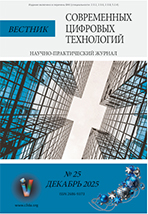
Вестник современных цифровых технологий № 24, сентябрь 2025 г. 
Вестник современных цифровых технологий № 23, июнь 2025 г. 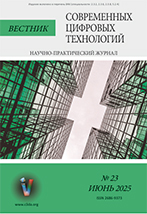
Вестник современных цифровых технологий № 22, март 2025 г. 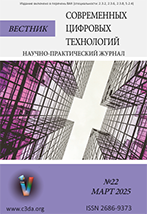
Вестник современных цифровых технологий № 21, декабрь 2024 г. 
Вестник современных цифровых технологий № 20, сентябрь 2024 г. 
Вестник современных цифровых технологий № 19, июнь 2024 г. 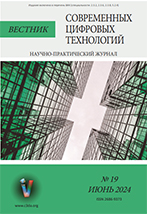
Вестник современных цифровых технологий № 18, март 2024 г. 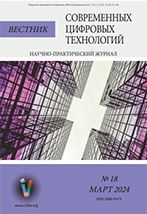
Вестник современных цифровых технологий № 17, декабрь 2023 г. 
Вестник современных цифровых технологий № 16, сентябрь 2023 г. 
Вестник современных цифровых технологий № 15, июнь 2023 г. 
Вестник современных цифровых технологий № 14, март 2023 г. 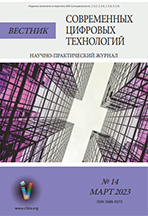
Вестник современных цифровых технологий № 13, декабрь 2022 г. 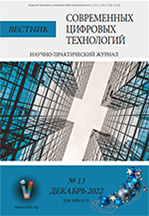
Вестник современных цифровых технологий № 12, сентябрь 2022 г. 
Вестник современных цифровых технологий № 11, июнь 2022 г. 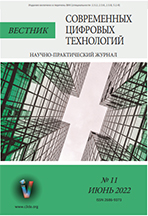
Вестник современных цифровых технологий № 10, март 2022 г. 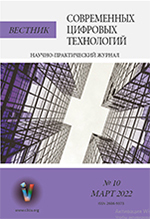
Вестник современных цифровых технологий № 9, декабрь 2021 г. 
Вестник современных цифровых технологий № 8, сентябрь 2021 г. 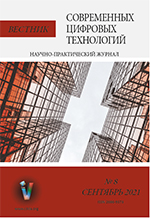
Вестник современных цифровых технологий № 7, июнь 2021 г. 
Вестник современных цифровых технологий № 6, март 2021 г. 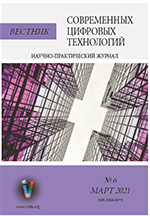
Вестник современных цифровых технологий № 5, декабрь 2020 г. 
Вестник современных цифровых технологий № 4, сентябрь 2020 г. 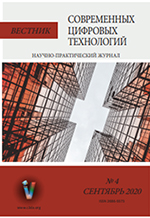
Вестник современных цифровых технологий № 3, Май 2020 г. 
Вестник современных цифровых технологий № 2, Февраль 2020 г. 
Вестник современных цифровых технологий № 1, Октябрь 2019 г. 
|
☑ Научно-практический журнал ☑ Порядок рецензирования журнала ☑ Редакционный совет ☑ Условия предоставления рукописей ☑ Аннотации и ключевые слова к статьям |
☑ Scientific and Practical Journal ☑ Review process ☑ Editorial board ☑ Submission terms ☑ Abstracts and keywords to the articles |
|
ABSTRACTS AND KEYWORDS TO THE ARTICLES
JOURNAL OF MODERN DIGITAL TECHNOLOGIES, №9 2022
On the Formulating a Systematic Approach to Research in the Field of Digital Platforms, Distributed Ledgers and Digital Assets A.V. Gleym, V.I. Egorov, D.I. Pravikov, A.A. Ryazanova, A.Yu. Shcherbakov Abstract. The article is devoted to the formation of a systematic approach to research in the field of digital platforms that combine technologies of distributed ledgers, digital assets and other relevant modern technologies, including machine learning and artificial intelligence technologies. It is shown that the integration of platform levels is possible from the cyber-physical level and the level of quantum communications to the level of storage systems implemented using a distributed ledger and the level of various business processes associated with the target function of the platform. The partial applicability of subject-object models of computer systems for describing platforms and their information security systems is shown, measures of integration level and security degree of platforms are introduced. Keywords: platform, service model, platform-service model, platform integration, distributed ledger, certification authority, infrastructure, cyber-physical system, quantum network, quantum keys, quantum cryptography, quantum communications, control and monitoring subsystem, trusted nodes, digital coin, zero knowledge, electronic signature, authentication code, blockchain, electronic signature, trusted key storage module, random number generator.
On the Method of Protecting the Interface of Interaction of Quantum Key Distribution Equipment and Means of Cryptographic Information Protection A.L. Alekseev, V.I. Egorov, A.Yu. Shcherbakov Abstract. The article is devoted to the formulation of a method for protecting the interface of interaction between quantum distribution equipment and means of cryptographic protection of information, which consists in using a hash function implemented within the framework of quantum equipment. Keywords: quantum key distribution, random number generator (RNG), means of cryptographic information protection, interfaces, controlled area, hash function.
Current Trends and Topical Issues in the Development of the Institutional Arrangements in the Field of Distributed Ledger Technologies and Digital Financial Assets A.A. Ryazanova, P.A. Cherkashin, A.Yu. Shcherbakov Abstract. The article is devoted to the main trends in the regulation of cryptocurrency circulation in the world and in Russia, the issues of determining the status and main concepts of digital technologies used in the financial sector. Examples and analysis of the shortcomings in institutional approaches in the issues of using technologies of distributed ledgers and digital financial assets are given. The reasons for the lag of the level of legal and economic understanding of the problem from the real needs of participants in the cryptocurrency circulation systems, as well as from the actual level of engineering achievements and fundamental understanding in the issues of digital financial assets and distributed ledgers, are indicated. Keywords: distributed ledger, digital financial asset, digital right, cryptocurrency, cryptocurrency exchange, central bank digital currency, information system operator.
JOURNAL OF MODERN DIGITAL TECHNOLOGIES, №8 2021
On the Issue of Determining the Subject Area of Information Security of Artificial Intelligence Technologies S.V. Zapechnikov, A.Yu. Shcherbakov Abstract. The article is devoted to the analysis of issues related to the definition of the subject area of information security of artificial intelligence technologies. The analysis of the composition and content of the subject area is carried out, typical threats to artificial intelligence systems and typical models of adversaries are highlighted. The features of information processing using artificial intelligence technologies that determine the tasks of ensuring information security are analyzed. An informal formulation of the privacy-preserving machine learning problem is given. Classification features and criteria for evaluating privacy-preserving machine learning systems are highlighted. The classification of known methods and systems that ensure the privacy and verifiability of machine learning is carried out. Keywords: artificial intelligence technologies, machine learning, deep learning, confidentiality, secure multi-party computations, secret sharing schemes, homomorphic encryption.
The Principles and the Protocol of the Registration and Distribution of Quantum Keys in Multinode Quantum Networks A.I. Volodin, K.A. Razgulyaev, D.V. Khan, A.Yu. Shcherbakov. Abstract. The problem of registration and distribution of quantum keys in multinode quantum networks that use cryptographic mechanisms to provide their own functionality and implement the platform-service model is considered. According to the approach that allows changing the algorithmic model of working with public key certificates to a physical one, in which quantum communications are responsible for the security of key distribution and symmetric cryptographic algorithms for the security of data transmission, a model of a reliable transactional digital platform using distributed ledger technologies is described. Keywords: quantum cryptography, quantum communications, authentication code, distributed ledger, blockchain, protocol, consensus, keys, electronic signature, key exchange, platform, hardware security module, random number generator (RNG), service model, platform-service model, certification centers.
On Creating the Russian Renewable Energy Certificate S.A. Borodulina, Yu.V. Zvorykina, V.V. Kuzmenko, D.V. Monakhov, P.A. Cherkashin, I.Yu. Shushkevich, A.Yu. Shcherbakov Abstract. The article deals with the concept and methodology of creating a system for circulation of green certificates for renewable energy sources with the participation of national regulators, which can provide trusted and independent cross-border circulation of green certificates. The presented methodology implies a high degree of protection of the green certificate from counterfeiting, tracking the movement and the ability to trace the location and the history of green certificates, as well as a significant reduction in the cost of their maintenance. The necessity of using symmetric cryptography mechanisms and rejection of certification centers is shown. The preliminary structure of the green certificate is given. Keywords: green pact, green certificate, renewable energy source, cross-border carbon tax, national regulator, zero processing, symmetric cryptography, electronic signature.
Ways of Distributed Ledger Technology Usage to Build Economic Security Systems for the Fuel and Energy Complex E.A. Chistyakova Abstract. The article discusses the ways of distributed ledger technology usage to ensure the economic security of fuel and energy companies. It is proposed to build the cross-industry blockchain platform to unite the largest oil and gas enterprises with other companies and provide the effective and safe interaction between them. The benefits that companies can derive from participating in the cross-industry blockchain platform are also identified, the two possible ways of the blockchain-platform development are considered. Keywords: distributed ledger technology, blockchain, cross-industry blockchain platform, smart contract, oil and gas industry.
JOURNAL OF MODERN DIGITAL TECHNOLOGIES, №7, 2021
The Current State of the Methodology for Constructing a Secure Quantum Network A.A. Santev, V.I. Egorov, E.V. Vereshchagina, S.E. Khoruzhnikov, A.Yu. Shcherbakov Abstract. The article is devoted to the topical problem of the organization of quantum-protected networks to ensure secure distribution of keys between remote subscribers and CIPF (cryptographic information protection facility). An approach to the organization of quantum networks based on trusted intermediate backbone nodes is considered, which makes it possible to form a quantum-protected key between the backbone network nodes based on quantum keys. The structure of the subsystem for organizing trusted intermediate nodes is described. Keywords: quantum cryptographic system for generating and distributing keys, quantum key distribution, quantum key, quantum protected key, means of cryptographic information protection.
Zero-Knowledge Proofs Privacy-Preserving Machine Learning S.V. Zapechnikov, A.Yu. Shcherbakov Abstract. The article is devoted to the analysis of a new scientific field – privacy-preserving and verifiable machine learning systems. Such systems allow to generate proof of the correctness for model learning and inference and to verify the proof by the customer of inference task and third parties, which guarantees the integrity of the evaluation process. The main tool for privacy-preserving and verifiable machine computing is zero-knowledge proofs. The article provides an example of a universal purpose zero-knowledge proof system and discusses the main ideas underlying the existing implementations of privacy-preserving and verifiable machine learning systems. Keywords: data mining, machine learning, deep learning, federated learning, confidentiality, secure multi-party computations, secret sharing schemes, homomorphic encryption.
The Substantiation of the Properties of Digital Platforms in the Framework of the Subject-Object Model of Computer Systems A.А. Ryazanova Abstract. The article discusses the basic concepts and properties of digital platforms from the viewpoint of the theoretical subject-object model of computer systems. The substantiation of the relationship between the properties of flows and processes of generation of subjects of a computer system with the properties of integrability and development of digital platforms is given. The influence of the properties of the digital platforms based on the subject-object model on the integrability of the information processes is described. Keywords: subject-object model, digital platform, integrability of the digital platforms, property of development, flow transitivity, processes integration.
Methodology for Сreating a Prototype of a Universal Digital Coin S.A. Borodulina, I.A. Selionov, A.A. Tyumentsev, P.A. Cherkashin, A.Yu. Shcherbakov Abstract. The article discusses the concept of digital coins as a means of achieving independence and mobility of the national financial system, reducing the cost of paper money circulation, strengthening the economic security of the state. The necessity of using symmetric cryptography mechanisms and rejection of certification centers is shown. The preliminary structure of a digital coin is given. A brief description of the system and technology of circulation of digital coins is presented. Keywords: digital coin, zero processing, asymmetric cryptography, national credit institution, national central bank.
The Сoncept of Information Security of the "Swarm" of Cyber-Physical Systems D.I. Pravikov, A.Yu. Shcherbakov Abstract. The article is devoted to consideration of possible approaches to ensuring information security, taking into account the peculiarities of cyber-physical systems in theoretical and practical aspects. The issues of information security assurance of a set of cyber-physical devices operating in the absence of a “secure perimeter” are considered. A solution to these issues is proposed by including the functions of forming an "intelligent swarm" with distributed mechanisms for ensuring information security in cyber-physical devices. An algorithm for ensuring information security of a "swarm" of cyber-physical devices is described. Keywords: cyber-physical system, insecure environment, information security of the swarm, application environment descriptor, distributed ledger, man-in-the-middle attack, subject-object model.
JOURNAL OF MODERN DIGITAL TECHNOLOGIES, №6, 2021 Zero-Knowledge Proofs and Their Applications for Information Processing into Untrusted Environments S. Zapechnikov Abstract. The article is devoted to the analysis of methodological and practical aspects of using in computer systems one of the most important cryptographic primitives – zero-knowledge proofs. A brief description of the main stages of zero-knowledge concept, the typology and characteristics of the properties of the most commonly used zero-knowledge proof systems are given. The article discusses typical models of computing in untrusted environments, and describes the information security requirements for these models. As examples, applications of zero-knowledge proofs in two areas are given: in distributed registry systems and privacy-preserving machine learning systems. In the final part of the article, current problems of the theory of zero-knowledge proofs and the practice of their application are considered. Keywords: probabilistic proofs, zero-knowledge proofs, cryptography, distributed ledgers, blockchain, privacy-preserving machine learning. Development Trends and Practical Implementation of Solutions to Ensure the Security of Cryptographic Networks V. Kuzmenko, V. Makarov, K. Razgulyaev, D. Khan, P. Сherkashin, A. Shcherbakov Abstract. Modern trends in ensuring the security of data transmission networks and ensuring the security of business processes are considered, the concepts and properties of cryptographic networks are formulated, the concepts of a service model and key containers are considered based on the development of quantum-protected networks, a practical solution and its architecture are described. Keywords: cryptographic networks, service model, protocol, keys, key containers, electronic signature, key exchange, security, encryptor, HSM (hardware security module) - module for trusted storage of keys. New Approaches to Acoustic Analysis of the State of the Human Body D. Tikhonenko, O. Tikhonenko, P. Cherkashin, G. Shipitsyna, I.Shushkevitch, G. Shipitsyna, I.Shushkevitch, A. Shcherbakov Abstract. The article is devoted to the formulation and discussion of a new approach to the study of the acoustic picture of the human body using a regular structure of microphones, which are analogous to a phased receiving antenna array, and further processing of information using mathematical methods of digital medicine. Particular attention is paid to passive methods of obtaining information about internal processes in the human body associated with the emission of acoustic vibrations from internal organs (heart, lungs). Keywords: acoustics, stethoscope, auscultation, ultrasound scan, digital antenna array (DAA), phased acoustic antenna array (PhAAA). JOURNAL OF MODERN DIGITAL TECHNOLOGIES, №5, 2020 Countering the Threat of Reduced Oil Production: Solutions, Application of Digital Models and Technologies N. Shushkevich Abstract. The article examines the prospect of reducing the total oil production in Russia as a threat to national security. The reasons and prerequisites for this problem are given. As possible direction author proposes to develop oil production from hard-to-recover reserves deposits. Also, it`s possible to start exploration and production in hard-to-reach and little-studied territories of the country. Potential difficulties are described for each of the proposed options. Much attention is paid to consideration of emerging problems associated with exploration and production on the Arctic continental shelf of Russia. An analysis of the impact of the imposed sanctions against the Russian oil and gas industry on some of the ongoing projects, including projects in the Arctic and on the Arctic continental shelf, is given. The final part contains the most significant and successfully implemented high-tech projects. The importance of using digital technologies to solve the mentioned problems is emphasized. Keywords: potential reduction in oil production, threat to national security, technological lag, sanctions against the oil and gas industry of Russia, Eastern Siberia, the Arctic, Arctic continental shelf Adaptive planning of production and procurement of medical equipment and components in order to create an effective system of reserves at the federal and regional levels A. Bely, E. Tikhomirov, S. Lutikov, I. Trufanov, A. Klementyev, A. Pastushkova Abstract. An approach to adaptive planning of production and procurement of medical equipment, in particular, artificial lung ventilation (ALV) devices, is considered, based on statistical data on the incidence of SARS-CoV-2 lung viral infection in the regions of the Russian Federation. A methodology for the formation of a baseline plan for the creation of federal reserves of ALV devices in the required volumes for medical and preventive institutions in the context of a mass illness of the population COVID-19 is presented. Keywords: artificial lung ventilation (ALV) devices, adaptive planning, coronavirus infection, medical prevention center (MPC), medical equipment, site of infection, pandemic, resources allocation. Cryptographic Techniques for Information Security in Distributed Ledgers S. Zapechnikov Abstract. The article analyzes the practice of using cryptographic techniques for information security in modern distributed ledgers. The main tasks of ensuring information security in distributed ledgers and tools for their solution are highlighted. Cryptographic techniques are systematized in accordance with their functions in distributed ledgers. Their properties, advantages, and disadvantages are discussed. Based on the results of the analysis, conclusions are drawn about the perspectives for using cryptographic techniques to solve the current information security problems facing the creators of modern secure distributed ledgers. Keywords: distributed ledgers, blockchain, information security, cryptographic hash function, digital signature, homomorphic encryption, zero-knowledge proofs, consensus protocols. On the Substantiation of the Requirements for the Process of Automation of Modeling in Medical Artificial Intelligence Systems A. Bely, E. Tikhomirov, A. Gaiduk, A. Shiryaev, A. Pekarsky, A. Ulyanov, S. Chechnev Abstract. The stages of the automatic modeling process are considered, the problem of the automated machine learning is formulated. The research and achievements of recent years in this area, areas of application and features of various approaches are presented. The problems and prospects of the development of automatic modeling systems are reviewed. Keywords: automation, deep learning, unified digital platform, machine learning, medical artificial intelligence, digital clinic, covid-19. Digital Blood Analysis Technologies Z. Tihonenko, O. Tihonenko, A. Shcherbakov Abstract. This article is devoted to the formulation of a new approach to blood analysis related to differential methods for measuring the number of blood cells and the speed of blood circulation based on the use of optical methods and as well as to applying for this purpose fitness wristband devices that use photoplethysmography. Keywords: blood, blood cells, photoplethysmography, matrix determinant, blood velocity, glucose level, blood composition, linear relations, optics, LED, monochrome radiation, coherence. Analysis of the use of universal sensors for monitoring human vital activity for the diagnosis of primary symptoms of COVID-19 А. Belyj, E. Tikhomirov, S. Lutikov, E. Anikeev, A. Klementiev, A. Pastushkova, V. Dorokhova Abstract. Variants of using a temperature sensor and a pulse oximeter for primary assessment of the physiological state of a person are considered for the early detection of symptoms of COVID-19 disease. An assessment is given of the possibility of integrating sensors into a universal medical device based on existing innovative developments for multimodal medical diagnostics and the creation of unified platform solutions. Keywords: proximity sensors, diagnostics, coronavirus, COVID-19, temperature sensor, pulse oximeter, multimodal medical diagnostics. Semantics of Language as a Source of Revelation O. Tikhonenko Abstract. A semantic and system-analytical approach to the analysis of the sacred texts is applied. This article continues a series of studies on the meaning of the letters of the primary language in which the texts of the Bible were written. The author uses the next two letters of the alphabet as examples, shows that each of the letters is associated with the previous and the next one through large number of semantic, theological and historical meanings and contents. Keywords:. Bible, alphabet, letter, digit, meaning, being, mind O. Nikolskaya Olivetti's "Programma 101" (P101): from social utopia to the first personal computer JOURNAL OF MODERN DIGITAL TECHNOLOGIES, №4, 2020 Prospects of Using Distributed Ledger Technology in the Education System A. Terpugov Abstract. The article considers the prerequisites for the formation of unified approaches to accounting of the knowledge gained by each subject of educational activity and the creation of conditions for awarding qualifications based on the accumulated knowledge through an automated procedure of reattestation, as well as automated recording and verification of documents which confirm the results of the gained knowledge. The rationale is given for creating a unified national educational platform based on a distributed register in order to implement a unified record of acquired knowledge in all educational programs passed by subjects of educational activity, including refresher courses. Keywords: knowledge exchange, cooperation of universities with companies, science policy, blockchain, distributed ledger, unified national educational platform. Prediction of Сhaotic Time Series Many Steps ahead V.Gromov, F. Baranov Abstract. In this paper, using the example of the Lorentz series, we consider several new strategies for predicting many steps ahead. The use of generalized z-vectors, composed of inconsistent observations, made it possible, within the framework of prediction approaches based on clustering, to construct for each point for which it is necessary to obtain a forecast, a sufficiently large set of possible forecast values. The analysis of these sets was carried out in two aspects: first, the determination of the possibility of obtaining a single predicted value for such a set; secondly, the construction of a single predicted value in cases where it is possible. The concept of unpredictable points made it possible to formulate a new problem of predicting many steps ahead, which assumes that the algorithm has the ability to distinguish between predictable and unpredictable points and to make a forecast in predictable ones. It was found that with increasing number of steps for which it is necessary to obtain a predicted value, the number of unpredictable points increases, while the error in the predicted points does not exceed a certain threshold value. The approaches proposed in this work to solving the problem of multistep prediction in this formulation made it possible to obtain predicted values at some points beyond the prediction horizon. Keywords: chaotic time series, prediction many steps ahead, prediction based on clustering, predictable and unpredictable points, prediction horizon. About a New Approach to the Implementation of Cross-border Verification of Electronic Signatures S. Borodulina, V. Grinevich, O. Tihonenko, A. Shcherbakov Abstract. The article discusses the possibilities of creating an international system of mutual verification and recognition of documents generated in various jurisdictions and provided with an electronic signature using various algorithms and keys. A method for reliable trusted storage, exchange and verification of documents based on a trusted distributed ledger, using the mechanisms of symmetric and asymmetric cryptography, is presented. Keywords: authentication code (AC), distributed ledger, blockchain, protocol, keys, electronic signature (ES), cryptographic information security (CIS), security, random number generator (RNG), certification authority (CA). Digital Platforms: Integrative Value, Basic Concepts and Attributes A. Ryazanova Abstract. The article introduces the basic concepts and attributes of digital platforms that distinguish them from information systems, analyzes the features and integrative value of digital platforms. It is shown that all the attributes of the digital platform are integrative, since they provide communication of subjects within the platform and interaction of platforms with each other. The example of digital platforms of some of the most important areas of social production shows the current level of development and compliance with the basic integrative attributes of platforms. Keywords: digital platforms, integration of digital platforms, attributes of digital platforms, potential for development information system. Semantics of Language as a Source of Revelation O. Tihonenko Abstract. A semantic and system-analytical approach to the analysis of the sacred texts is applied. This article continues a series of studies on the meaning of the letters of the primary language in which the texts of the Bible were written. The author used the next five letters of the alphabet as examples, shows that each of the letters is associated with the previous and the next one through large number of semantic, theological and historical meanings and contents. Keywords: Bible, alphabet, letter, digit, meaning, being, mind Calligraphy and Applied Aspects of Handwritten Text Processing N. Gruzdeva Abstract: Important aspects of the evolution of handwriting are described in this article on the example of calligraphic writing, taking into consideration the aspect of tracing manuscript. Key points of handwriting’s digital representation are contemplated and an analysis of the possibility for the hardware reproduction of handwriting is carried out in consideration of textual and descriptive constituents. In this article we suggest a hypothesis that handwriting is no more the confirmation of the authorship and can be computer-assisted repeated and emulated. In that context, authenticity of any handwriting is in question, and that offers great opportunities for criminalistics and development of new technologies for personal identification. Keywords: calligraphy, grapheme, handwritten text, computer fonts, character encodings, optical character recognition, three-dimensional printing, machine text reproduction. JOURNAL OF MODERN DIGITAL TECHNOLOGIES, №3, 2020 Possibilities of using distributed registries for the exchange of scientific knowledge A. Terpugov Abstract. The article discusses the possibilities of changing traditional scientific practices of interaction and models of cooperation, in which the exchange of knowledge is significantly limited by the desire of scientists to publish in highly rated journals in response to state requirements for publication activity, as well as by intellectual property rights that determine the "closed" nature of partnership. The key approaches to the development of open science are presented, based on the creation of tools for the trusted exchange of scientific knowledge between members of the scientific community within the framework of a distributed registry platform. Keywords: open science, open access, knowledge sharing, cooperation of universities with companies, scientometrics, science policy, exchange of scientific knowledge, blockchain, distributed registry. A new approach to ensuring perimeter security of business processes and user authentication in a corporate system V. Kuzmenko, V. Makarov, K. Razgulyaev, D. Khan, A. Shcherbakov Abstract. A new approach to ensuring the security of business processes, ensuring the impossibility of transmitting confidential information beyond the perimeter of the organization associated with the use of user key storage modules, is considered. Keywords: authentication code, distributed registries, blockchain, protocol, keys, electronic signature, key exchange, security, encryptor, platform, HSM (hardware security module), module for trusted key storage, random number sensor (DNS) On the concept of smart contracts implementation S. Gostev, P. Murzin, D. Pravikov, A. Shcherbakov Abstract. This paper describes a particular case of information security during two-party interaction while transferring assets with zero trust to each other. We propose a toy problem devoted to anonymous asset transfer and provide a generalized algorithm for solving it. We then describe the technical implementation of the algorithm as a smart contract in a generalized distributed ledger. Finally, we show limitations for proposed approach and provide a brief overview of alternative solutions. Keywords: smart contract, distributed ledger, messenger task, anonymous asset transfer. Forecasting and predictive analytics of technical systems as a part of technological safety. New approaches D. Pravikov, O. Tihonenko, A. Shcherbakov Abstract. The article discusses the description of the functioning of cyberphysical systems in order to obtain characteristics in an undisturbed state. A hypothesis is introduced that the detection of negative effects is possible through the identification of deviations from stationary characteristics described by quasianalytic dependence. Based on the processing of the experimental results, it is shown that for cyber-physical systems the characteristics have a periodic dependence. Implementation of the new method on the Prognotech platform is proposed, implementation advantages are described. Keywords: cyber-physical systems, criteria for stable functioning, quasianalytic dependence, power oil transformer, Prognotech platform. M. Ivanova The usage of Distributed Ledger Technology to ensure the economic security of the fuel and energy complex Abstract. The relevance of chosen topic is due to the need of reliability and security improvement in business processes in the fuel and energy complex, in particular in oil and gas industry. The article considers the possibility of using distributed ledger technology (blockchain) in the main areas of oil and gas industry. The areas in which the usage of distributed ledger technology can lead to improving security in terms of economic processes are analyzed. Conclusions that the technology has great potential for growth, improvement of existing mechanisms and the creation of new, more effective ones are given. Keywords: distributed ledger technology, blockchain, Internet of things, smart contract, oil and gas industry. Semantics of language as a source of revelation O. Tihonenko Abstract. A semantic and system-analytical approach to the analysis of the sacred texts is applied. This article continues a series of studies on the meaning of the letters of the primary language in which the texts of the Bible were writed. The author used the next two letters of the alphabet as examples, shows that each of the letters is associated with the previous and the next one through large number of semantic, theological and historical meanings and contents. Keywords: Bible, alphabet, letter, digit, meaning, being, mind JOURNAL OF MODERN DIGITAL TECHNOLOGIES, №2, 2020 Platform "Kupol" as a prototype of the state trusted and certified system of distributed registries O.Ovchinnikov, S.Gostev Abstract. This article discusses the requirements and approaches to designing a secure distributed registry, as well as the ecosystem of the software package «Kupol-SKZI» (cryptographic information protection system) designed to build cryptographically secured distributed data storages as part of automated information management systems that process information that does not contain state secret information. Keywords: distributed registries, platform, information ecosystem, distributed data storages, certification. About a way of storing and managing keys in quantum communication systems K. Razgulyaev, A. Ryazanova, D. Khan, A. Shcherbakov Abstract. The problem of integrating quantum communication systems into platform solutions of digital technologies that use cryptographic mechanisms to provide functionality is considered, the thesis that the development trend of the security paradigm of distributed untrusted systems is the transition from algorithmic security to the synergy of technical and cryptographic solutions is illustrated. Keywords: quantum cryptography, quantum communications, authentication code, distributed registries, blockchain, protocol, consensus, keys, electronic signature, key exchange, security, encryptor, platform, HSM (hardware security module) - module for trusted key storage, random number generator (RNG) . The importance of distributed ledger technology for improving the quality of new scientific knowledge А. Ryazanova Abstract. The article discusses the most important aspects of the impact of distributed ledger technology as a tool for scientific information and scientific research processes integration on the effectiveness of scientific research. Exoplanet search in astronomy is used as an example. A comparative analysis confirms the potentially high level of positive impact of distributed ledger technologies on the quality of research practice and on the results of scientific research. In addition, the concept of a multiproject distributed registry is introduced. Keywords: digital scientific communications, scientific research, integration of scientific and information processes, distributed registries, multiproject distributed registry, exoplanet search, scientific research management. Integrated industrial equipment security D. Pravikov, A. Shcherbakov, N. Korneev Abstract. The paper considers approaches to providing integrated security for the functioning of modern industrial systems related not only to ensuring information security through the control channel, but also to the industrial safety of controlled equipment, as well as its other aspects. Keywords: integrated security, industrial safety, monitoring and diagnosis systems, detection of complex threats. Prospects for the use of blockchain technology in medicine O. Andreeva Abstract. This article discusses the urgent problem of data storage and processing in medical information systems with the possibility of ensuring integrity and consistency of medical data. The prospects of using the technologies of distributed registries in the field of clinical trials, pharmacology, statistical analysis of medical data, systematization of scientific information aimed to improve the technological effectiveness and safety of the medical treatment, are discussed. Keywords: distributed registries, decentralization, platforms, medical information systems, clinical trials, electronic health records. An integrated solution of the problem of non-payments in the field of housing and utilities services by using trusted domestic software of a distributed registry S. Yarmolinsky Abstract. The article is devoted to the urgent task of a integrated solution of the problem of non-payments in the housing and utilities sector with the use of fiat money. A model of calculations based on a distributed registry and smart contracts using trusted domestic software is proposed.,/p> Keywords: distributed register, smart contracts, payment for housing and utilities services, unique single payment document, accounting non-bank credit organizations, ARP companies JOURNAL OF MODERN DIGITAL TECHNOLOGIES, №1, 2019 International consensus as developing of the consensus paradigm A. Domashev, A. Shcherbakov Abstract. The article is devoted to the most important problem of distributed registries - the legitimacy of the consensus procedure. Based on a review of the history of distributed registries and a comparative analysis of various projects using the blockchain, the situation is illustrated and substantiated that in order to create completely legitimate procedures for international interaction in the field of distributed storage and processing of data, it is necessary to move to the paradigm of international consensus whereby the subjects of the consensual procedure are subjects of international law or their authorized bodies.,/p> Keywords: distributed registry, international consensus, distributed storage, cryptocurrency, trusted international platform. S. Zapechnikov Abstract. The article deals with the problems of cryptographic protection of data processing. This is a set of novel techniques allowing to process private information without disclosing it to persons engaged in processing. We review important building blocks for cryptographic protection of data processing, such as zero-knowledge proofs, secure multi-party computations and homomorphic encryption. Often, big data processing includes data mining and machine learning algorithms, so privacy-preserved machine learning is very important task. The concept of differential privacy is analyzed which is the basis for privacy-preserving machine learning and some other cryptographic schemes. It is noted that one of the main applications of such security tools is the creation of personalized information services, which opens up new opportunities for business and reduces the risks of unauthorized access to personal data. Keywords: cryptographic protocols, zero-knowledge proofs, secure multi-party computations, homomorphic encryption, privacy-reserving machine learning, personalized information services. The main approaches to developing a consensus protocol in distributed registries P. Murzin Abstract. This paper provides a brief overview of existing consensus protocols in distributed ledgers. The issues of decentralization, confidentiality and anonymity are considered. The classification of blockchains and existing solutions to the problems of network scalability are given. An approach to the development of a fast and scalable private blockchain is proposed. Keywords: distributed ledgers, consensus, decentralization, scaling, anonymity, completeness models. Cybersecurity as a new fundamental research area in the field of information security D.Pravikov, A.Petukhov Abstract. The article considers an approach to the scientific substantiation of the concept of cybersecurity. Based on the analysis of the structure of an ideal social system, types of processed information are introduced, it is shown that the existing traditional approaches to ensuring information security are associated with only one of its types. The proposed approach is correlated and built into the existing system of approaches to ensuring information security. The definition of cybersecurity is formulated. A formal description of cybersecurity as a product of predicates is proposed. Keywords: cybersecurity, security of the protected object, integrated security system, social and technical system. Opportunities of cryptocurrencies in favour of stabilizing and developing financial markets and national monetary systems Yu. A. Shushkevich Abstract. The article focuses on impact which cryptocurrencies provide on financial markets and national monetary systems and reveals the causes of variations in policies regarding cryptocurrencies in different states. The mechanisms through which cryptocurrencies circulation can cause damage or, conversely, create competitive advantages for national financial markets, are shown. A proven conclusion is made that the Russian Federation fundamentaly benefits from significant and long-term prerequisites of using national cryptocurrency in the interests of support international trade and ensuring national interests under unilateral sanctions and restrictions by the United States and other western countries. Basic characteristics and operating principles of possible Russian national cryptocurrency are given, as well medium– and long-term forecast of its impact on development of financial market and formation background for strengthening Russian ruble with the prospect of its becoming a full-fledged mean of international transactions and reserve currency in global scale. Keywords: cryptocurrency, Bitcoin, Ethereum, Tether, Libra, Stock market, Debt market, Foreign exchange market, Monetary system, Fiat currencies, China, USA, Switzerland, National Russian Cryptocurrency, Sanctions, Global reserve currency. |
||

